If you head into the wilderness I’m sure you know not to leave trash behind – Pack it in, pack it out, right? But what else do you need to know to protect nature (and avoid being an a-hole)? I’ve been teaching people about how to Leave No Trace when hiking and camping for decades.
I started out as a Leave No Trace Trainer back in 2006. In 2019, I got certified as a Leave No Trace Master Educator (now called a Level 2 Instructor). In this post I’ll help you understand the basics of Leave No Trace including:
- What is Leave No Trace? What does it mean?
- Why is Leave No Trace important?
- The 7 principles of Leave No Trace and how to implement them
What is Leave No Trace?
After noticing increased impacts like trash and campfire scars on heavily used trails in the Sierra Nevada mountains of California, the US Forest Service developed the 7 Principles of Leave No Trace in the 1960s. Since then, Leave No Trace (often shortened to LNT) has become a registered non-profit with chapters around the world.
The idea behind the principles is to leave nature as unchanged by our presence as possible, so that future generations can enjoy it too. In essence, the purpose of Leave No Trace is to keep the wilderness wild.
I’ve heard people dismiss the idea of Leave No Trace as pointless since it’s impossible not to leave tiny traces wherever we go. However, those people are missing the point – we are looking for progress, not perfection. The principles of Leave No Trace guide us to leave as little impact as we can.
Why is Leave No Trace Important?
As more and more people chose to hike and camp and camp in wilderness areas, lessening our impact is becoming more important. In many areas some trails are getting loved to death by large crowds, garbage and environmental damage. This was especially true during the pandemic.
I firmly believe that nature is for everyone. Both experienced outdoors-people and newbies deserve to experience the outdoors.
But in order for that to happen, we all need to learn a bit more about how to be responsible hikers and campers. Remember that we were all beginners once.
My Introduction to Leave No Trace
On one of my first backpacking trips I washed the crusty noodles out of my pot… into a tiny alpine stream. I was surprised when they just sank to the bottom instead of magically flowing away (like they would in my sink at home).
I knew I was doing it wrong… but I didn’t know what else to do. It was an important moment for me. I realized that I didn’t know what I didn’t know.. and that I needed to learn more about how to treat the wilderness. I did some research and learned about the Leave No Trace principles.
Maybe you’ve had a similar a-ha moment. Did you see trash in a campsite? Were you concerned about overcrowding in a National Park? Did you come across unburied human poop?
We all start somewhere in our Leave No Trace journey. It’s ok to admit you didn’t know. But we can all take a bit of time to learn how to do better next time.
The 7 Principles of Leave No Trace
It’s important to know the seven principles of Leave No Trace. When I teach people about LNT, I find that the info sinks in better if they know the “why” and “how” behind each principle.
Remember that the 7 principles of Leave No Trace are not rules – they are guidelines that we can look to when we make decisions about how to behave outdoors.
Plan Ahead and Prepare
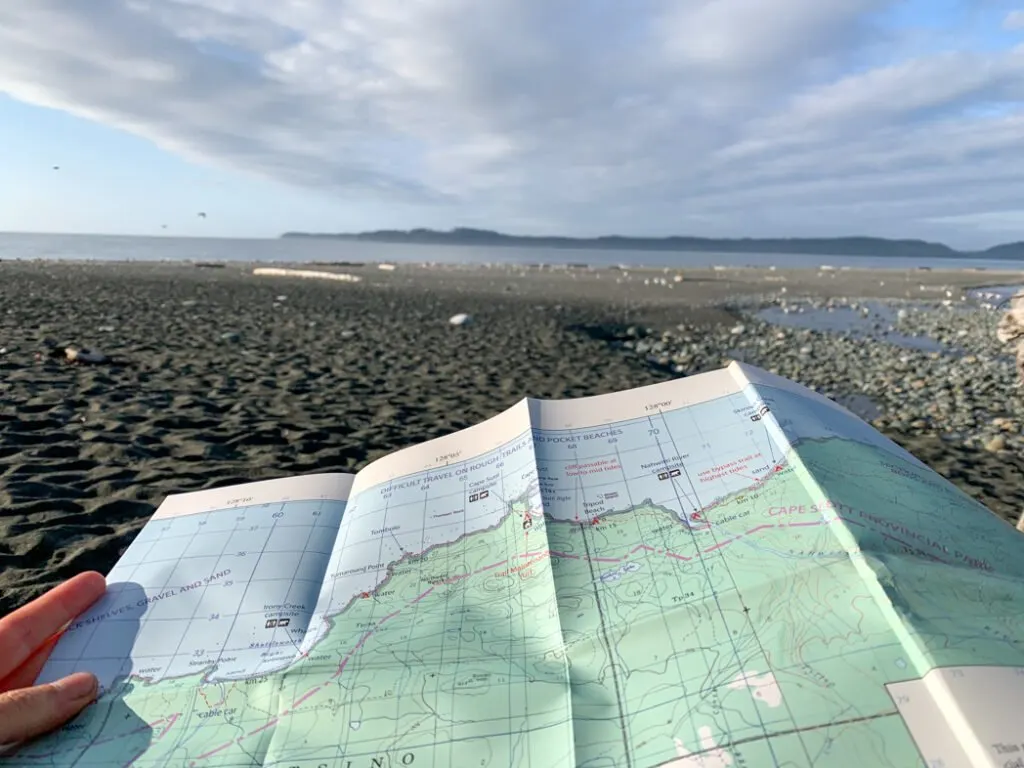
What Does Plan Ahead and Prepare Include: Research trail info, weather forecasts, park rules, and trail conditions before your hike.
Why: When you do some research before your hike, you are more likely to have a fun and SAFE hike. You will also minimize damage to nature.
How:
- Check the weather forecast and trail conditions to make sure you have the right gear and you are up to the challenges of the trail. (Read my guide to best weather apps for hikers.)
- Check local regulations to find out about closures, permits, fire regulations or other policies.
- Bring a first aid kit and the 10 essentials in case not everything goes according to plan.
- Avoid getting lost: bring a map and compass, a GPS and a trail description to stay on track.
- Repackage food to create less waste on the trail.
READ NEXT: 16 Things to do Before a Hike
Travel and Camp on Durable Surfaces
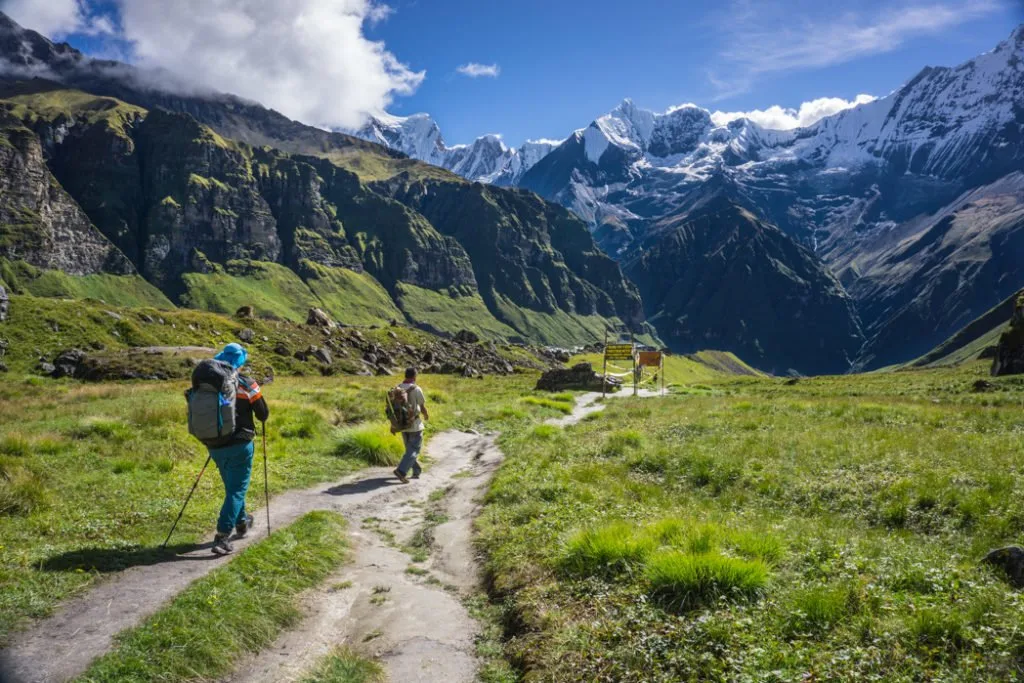
What Does Travel and Camp on Durable Surfaces Mean? Hike and camp on durable surfaces like rocks, gravel, and snow.
Why: Some surface like alpine meadows, marshes and bogs are just too fragile to withstand much impact. The vegetation in those areas can take years to grow, and then be destroyed by a few boot-prints.
How:
- Stay on the trail to prevent trampling vegetation. Walk through mud, not around it to avoid widening the trail. Don’t cut corners on switchbacks since that causes erosion.
- In areas with no trails, spread out your tracks to spread out the impact and avoid creating a new trail.
- Camp in a designated campsites or ones that have been used before. Remember the best campsites are found, not made. (You don’t need to dig trenches or cut trees.)
- If there are no designated or previously used campsites, camp on gravel, bare dirt, snow or dry grass to minimize your impact.
- Try to camp at least 200ft/70 m from water sources. The plants by lakes and streams very fragile. Animals need to access water to drink and your presence may scare them off or cause conflict.
Dispose of Waste Properly
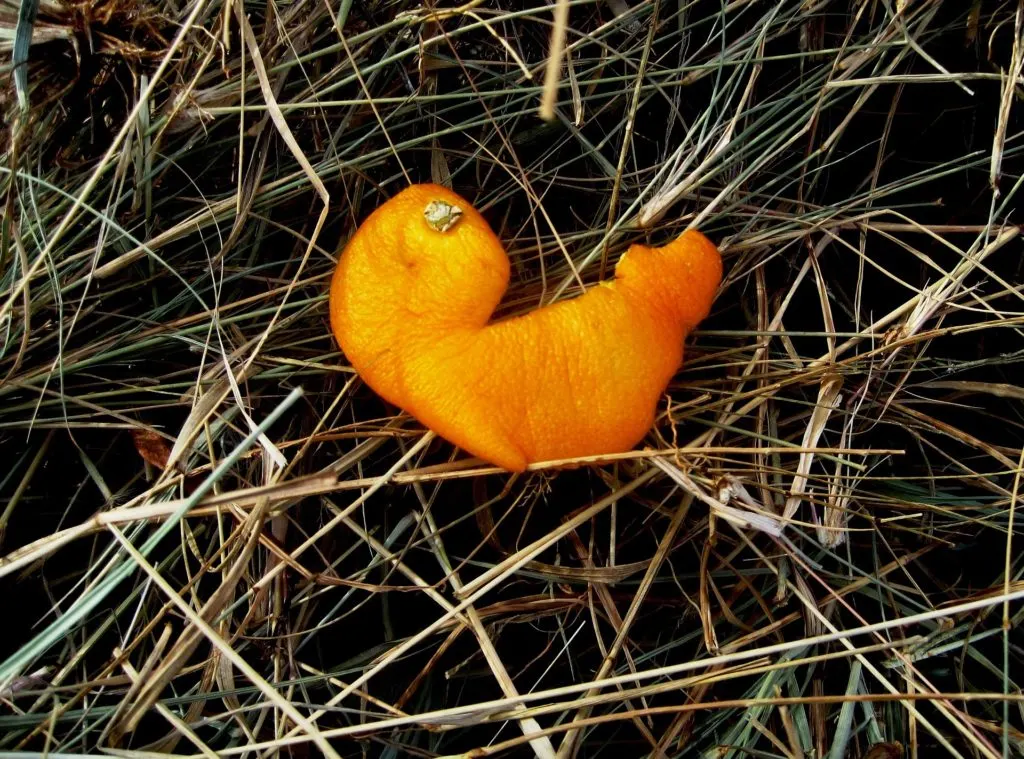
What Does Dispose of Waste Properly Mean? Pack out all garbage and food scraps. Learn how to poop and wash the Leave No Trace way.
Why: Animals who learn to eat people food or human waste may stop eating their natural food or may attack people. It can also make wildlife sick. Garbage, poop and soap can pollute water, making it unsafe to drink or killing plants and fish. Plus garbage and poop on the trails looks disgusting!
How:
- Pack out your trash, including fruit peels and eggshells. They can take months to biodegrade and in the meantime they attract animals. I like to say “It it doesn’t grow there, it doesn’t go there.”
- Never burn your trash in a campfire. Some materials don’t burn very well so you might leave a mess.
- Wash dishes and yourself in biodegradable soap using your largest pot as a sink. Strain out any large particles then dump your dirty dishwater 200ft/70m from a water source. (Just because soap is biodegradable doesn’t mean it’s good for fish or plants so it shouldn’t go directly into the water source.) Try going without soap – sometimes a wet cloth or a scrubber is all you need.
- When possible, use an outhouse or pit toilet.
- If you have to poop and there is no outhouse, pick a spot 200ft/70m away from trails, campsites and water sources. (This keeps water sources clean so people won’t get sick.) Use a small trowel, a tent peg or a stick to dig a hole 6″/15cm deep, then bury your poop.
- Pack out your menstrual supplies. Learn more about how to camp and hike with your period.
- Pack out your dog’s poop in a plastic bag or bury in it just like you would human poop. Wild animals like to eat dog poop but it is full of bacteria and parasites that they aren’t used to. (Get more Leave No Trace tips for hiking with dogs.)
- Bring a ziploc bag to pack out your used toilet paper. If you packing it out grosses you out, be sure to bury it with your poop. Another alternative is to use natural TP like moss, leaves, rocks or snow. (Snow is particularly refreshing!)
Leave What You Find

What Does Leave What You Find Mean? Leave natural and historical items like flowers, rocks, pictographs, artefacts, etc. where you find them. Don’t move them or bring them home with you.
Why: Leaving the trail the way you found it lets others enjoy it too. It also keeps ecosystems intact.
How:
- Leave flowers, rocks and historical artifacts where nature put them. Take a photo and then leave them for others to enjoy. If we all picked a flower or brought home a rock, there wouldn’t be any left.
- Good campsites are found, not made. Avoid building structures, cutting trees or digging trenches.
- Graffiti is never acceptable.
- Don’t build extra inukshuks, rock stacks or cairns unless they are necessary as trail markers. Building rock stacks can confuse hikers who might they are trail markers. (Did you know many insects and animals live under rocks? When you move them you destroy their homes.)
Minimize Campfire Impacts

What Does Minimize Campfire Impacts Mean? Plan to cook over a stove, not a fire. If you do build a campfire, learn how to minimize your impact.
Why: Campfires can have negative impacts. They damage the soil and can lead to excessive firewood harvesting in sensitive areas. Plus forest fires are pretty terrible.
How:
- Always bring a stove instead of planning to cook on a fire. It’s quicker, more fuel efficient and has less impact on the wilderness.
- Consider having a campfire-free night by using a small lantern instead.
- Check regulations before you go to find out if fires are allowed. Many areas have fire bans in place during dry spells or to protect sensitive ecosystems like the alpine or grasslands where fires are not appropriate due to fragile soils, short growing seasons for plants, the ease of wildfire spreading and/or a lack of firewood.
- If you do make a fire, use an existing fire ring and avoid building new ones.
- Keep your fire small.
- Use dead wood that is already on the ground to avoid harming trees. (It burns better too.) Choose small sticks that you can break up with your hands.
- Put your fire out completely when you are done.
Respect Wildlife
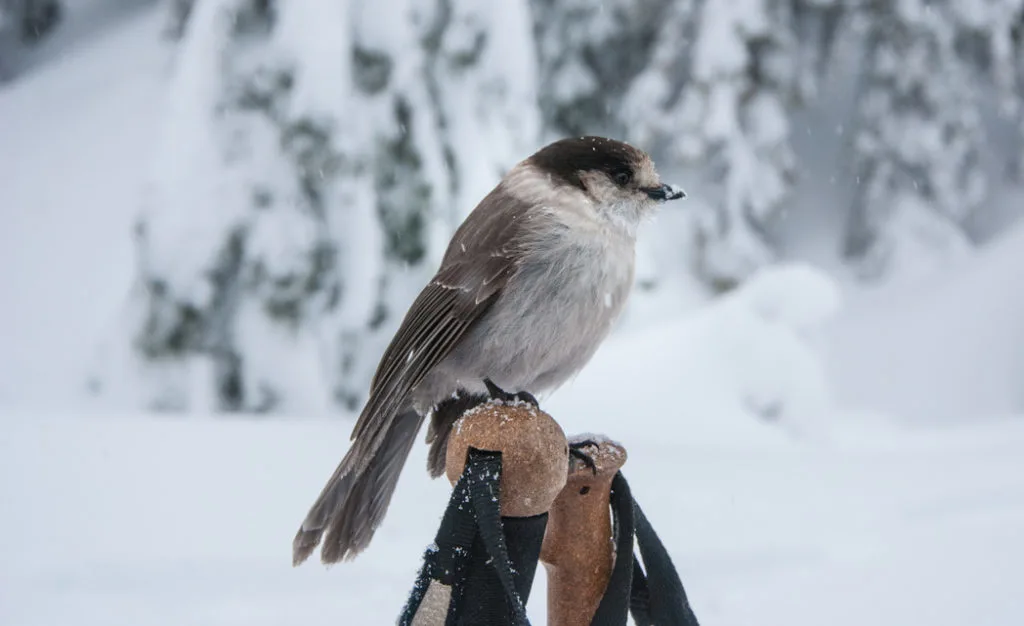
What Does Respect Wildlife Mean? Give animals some space, and make sure your dog does too. Don’t let animals have human food.
Why: The wilderness is the animals’ home and it deserves respect. They need enough space to maintain their natural behaviour and may attack if provoked. Dogs love the outdoors too but their prey-drive means they may harass wildlife.
How:
- Never feed animals. Your human food isn’t healthy for them and if they develop a taste for human food, they may lose their ability to find food naturally. Some cute animals like squirrels and whiskey jacks have learned to beg for food. Don’t give in!
- Don’t let animals have access to your food. Never leave food unattended. When camping safely store your food for the night inside a food locker or bear canister or learn how to properly hang it in a tree.
- Observe animals from a respectful distance. Use binoculars or the zoom lens on your camera to get a better look.
- Keep your dog on a leash and under control so they don’t chase or bother wildlife. You might think that it’s not a big deal for your dog to chase a squirrel… but if they chase a bear both you and your dog might think it’s a big deal! Research local rules before you go to find out if dogs are allowed and if leashes are required. (Get more tips for Leaving No Trace with your dog.)
READ NEXT: Bear Safety for Hikers, Campers and Backpackers
Be Considerate of Other Visitors
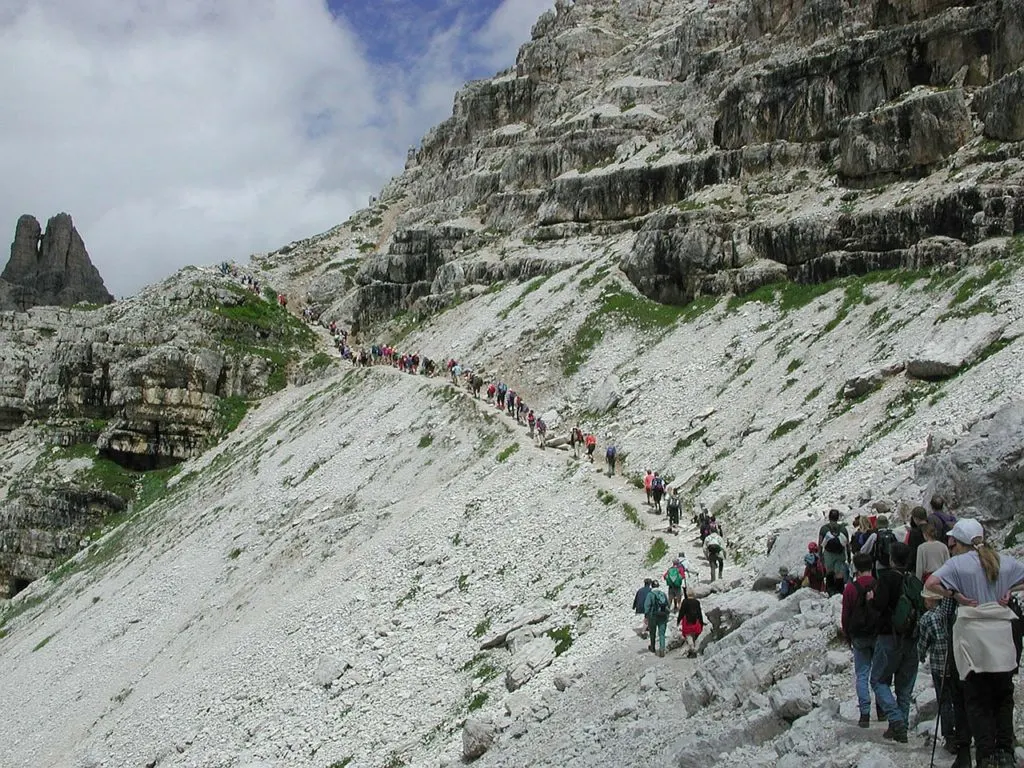
What Be Considerate of Other Visitors Mean? Keep the experience of other visitors in mind so that your actions don’t negatively impact someone else’s experience. Learn and follow trail and camp etiquette.
Why: We all need to share trails and campsites in order to let everyone experience the wilderness. Some people go hiking for fitness, others to socialize and others hike to spend time in nature. Respect the way that other people wish to experience the wilderness and try not to let your experience negatively impact theirs.
How:
- Yield to other users on the trail. Step off the trail to take breaks so you aren’t in someone’s way.
- Give other groups space at viewpoints or in camp. If there’s a popular photo spot, snap a few pics, then move aside so someone else can have their turn.
- Keep your voice low and avoid yelling. Keep your group together to avoid shouting back and forth. (You’re safer that way too.)
- Leave the music at home (or wear headphones if your life requires your own personal soundtrack). Most hikers and campers want to hear the sounds of nature, not music.
- Keep your group small to create less impact, take up less space and make less noise. A good guideline is no more than 8-10 people.
READ NEXT: 15 Ways to Avoid Crowded Hiking Trails
Final Thoughts
This is just a broad overview of how to Leave No Trace when hiking and camping. If you are interested in learning more about Leave No Trace you can visit leavenotrace.ca or lnt.org. On those sites you can also find listings for Leave No Trace awareness course providers in your area.
Keep Leave No Trace in mind when hiking and camp so we can all keep the wilderness wild.
READ NEXT:
- How to Leave No Trace With Dogs
- 16 Things to do Before a Hike
- Bear Safety for Hikers, Campers and Backpackers
- Tips for Safe Hiking in Wildfire Season
- The Best Weather Apps for Hiking
- Bowron Lakes Canoe Circuit: 2026 Paddling Guide - November 20, 2025
- 2026 BC Backpacking Reservation Dates You Need to Know - November 20, 2025
- 2025 Black Friday Deals for Hikers - November 19, 2025


Dawn
Sunday 25th of November 2018
Thank you for writing this - it's a positive reminder. The biggest garbage I picked up was two car batteries in our kayaks (left in the middle of no-where!) and the garbage that no one bothered to clean-up at the top of black mountain turned out to be 30 euros! Still can't erase the couple I saw in the middle of the wildflowers at Manning - so sad.
Taryn Eyton
Sunday 25th of November 2018
I'm glad you liked it. I like to believe the best of everyone and give them the benefit of the doubt. I sincerely hope that people who treat wild areas badly just don't know any better - and that if we can reach them with education they won't make the same mistakes again.
Michaela
Saturday 13th of October 2018
Really good instructions! It should be mandatory for everyone to read this before heading to the wilderness :)
Suzy
Saturday 13th of October 2018
Another great post. I am a firm believer of LNT - which is a little harder now I have a toddler with curious hands trying to pick flowers, etc... Still we try and teach respect from the start. The photo of orange peel resonated with me. I was out in a national park a few weeks back and we came across an apple tree sampling at the picnic area. These are not native to the area and I can imagine it would have grown from a discarded apple core. I think people think that these things just rot down and become soil but they can grow and be disruptive to the native species.
Taryn Eyton
Saturday 13th of October 2018
Yes - non-native species can be a huge problem in some areas! So nice to hear you are teaching your child about Leave no Trace :)
Kirstin
Friday 12th of October 2018
I recently started a world trip venture with my partner, in which we are road-tripping and camping/hiking our way around. It has been unbelievable to see just how much garbage is left EVERYWHERE... and has been especially saddening to see just how much there is here in Mexico, especially in the oceans. Hopefully posts like this will help to educate the masses!
lkvy
Friday 12th of October 2018
Did you take that photo of the Dolomites?!
If I have room in my backpack, or I'm close to the end of the trail, I pick up other people's garbage. Last summer, I picked up what I thought was just a ziploc bag. Upon closer inspection, there was weed inside! Score! XD
Taryn Eyton
Friday 12th of October 2018
The photo of the Dolomites is a free stock photo - I don't know if I would have been able to deal with that many people in person! I also pick up other people's trash - I usually bring a garbage bag exactly for that purpose. My best score is a pair of Arc'Teryx gloves - yours sounds better :)